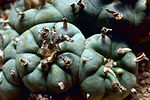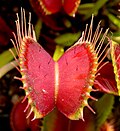Peyote (redirect from Lophophora williamsii)
The peyote (/peɪˈoʊti/; Lophophora williamsii /ləˈfɒfərə wɪliˈæmziaɪ/) is a small, spineless cactus which contains psychoactive alkaloids, particularly...
34 KB (3,874 words) - 07:27, 23 July 2024
Lophophora (/ləˈfɒfərə/)[citation needed] is a genus of spineless, button-like cacti. Its native range covers Texas through Mexico to southwestern Mexico...
5 KB (390 words) - 16:12, 5 June 2024
spirituality traditionally involves collecting and consuming peyote (Lophophora williamsii), a cactus that possesses hallucinogenic effects due to its psychoactive...
34 KB (4,227 words) - 19:03, 26 July 2024
Lophophora diffusa, commonly known as false peyote, is a species of plant in the family Cactaceae and one of the species in the Lophophora genus. It is...
3 KB (258 words) - 10:15, 22 May 2023
Echinopsis lageniformis, syn. Trichocereus bridgesii), and Lophophora, with peyote (Lophophora williamsii) being the most psychoactive species. Several other...
13 KB (1,015 words) - 07:17, 23 July 2024
from phenylalanine by the enzyme phenylalanine hydroxylase. In Lophophora williamsii (Peyote), dopamine converts into mescaline in a biosynthetic pathway...
52 KB (4,951 words) - 00:30, 29 July 2024
Tabernanthe iboga Voacanga africana Tabernaemontana undulata Cactaceae Lophophora williamsii Echinopsis pachanoi Echinopsis lageniformis Echinopsis peruviana...
9 KB (792 words) - 13:22, 19 March 2024
history of use by the indigenous peoples of the Americas: peyote, Lophophora williamsii, in North America, and the San Pedro cactus, Trichocereus macrogonus...
108 KB (12,427 words) - 18:18, 27 July 2024
alkaloid in Lophophora williamsii (in terms of quantity) is mescaline, followed by pellotine. In the species Lophophora diffusa and Lophophora fricii, the...
4 KB (386 words) - 21:41, 24 July 2024
The band's name is taken from the peyote cactus' scientific name, Lophophora williamsii. Originating from the French alternative scene, Lofofora was formed...
8 KB (679 words) - 17:32, 25 June 2024
Echinopsis lageniformis and Echinopsis scopulicola) and the species Lophophora williamsii (peyote). Mescaline induces a psychedelic state comparable to those...
22 KB (2,161 words) - 07:29, 23 July 2024
psychedelic drug and the main psychoactive constituent of peyote (Lophophora williamsii), San Pedro cactus (Echinopsis pachanoi), and Peruvian torch cactus...
79 KB (9,247 words) - 06:21, 17 June 2024
theory that its use as a hallucinogen predates that of peyote (Lophophora williamsii). A tea from the branches and more so from the roots and fruits...
3 KB (252 words) - 20:03, 15 May 2021
28 September 2016. Retrieved 11 October 2017. Terry M (2013). "Lophophora williamsii". IUCN Red List of Threatened Species. 2013. doi:10.2305/IUCN.UK...
33 KB (3,391 words) - 17:06, 12 July 2024
Claviceps paspali (Ergot) Datura suaveolens Erythroxylum coca Lophophora williamsii (Coto Peyote) Mitragyna speciosa Papaver somniferum Prestonia amazonica...
26 KB (1,685 words) - 02:08, 21 February 2024
maternal plant. Marantaceae Minnieroot (Ruellia tuberosa) Peyote (Lophophora williamsii) stamens move in response to touch Kinesis (biology) Nastic movements...
10 KB (912 words) - 06:11, 2 July 2024
Anhalamine is a naturally occurring alkaloid which can be isolated from Lophophora williamsii. It is structurally related to mescaline. Anhalinine Anhalonidine...
2 KB (95 words) - 13:13, 21 January 2024
religious tradition involving the ceremonial and sacred use of Lophophora williamsii (peyote). Use of peyote for religious purposes is thousands of years...
31 KB (3,623 words) - 13:29, 7 June 2024
has excluded San Pedro Cactus (Echinopsis Pachanoi) and peyote (Lophophora Williamsii) from the list of illicit drugs, psychotropic substances and precursors...
14 KB (418 words) - 13:26, 11 June 2024
influence of the psychotropic plants that Don Juan offered him, peyote (Lophophora williamsii) and a smokable mixture of what Castaneda believed to be, among...
3 KB (266 words) - 17:47, 11 November 2022
Britton & Rose (as E. wislizeni Engelm.) Lophophora williamsii (Lem. ex Salm-Dyck) J.M.Coult. (as E. williamsii Lem. ex Salm-Dyck) Turbinicarpus subterraneus...
5 KB (260 words) - 13:11, 21 January 2024
as a minor alkaloid in some plants, such as the peyote cactus, Lophophora williamsii, and a species of Acacia, as well as in Scotch Broom, Cytisus scoparius...
11 KB (1,372 words) - 22:14, 25 July 2024
Evans (1 October 1938). Spier, Leslie (ed.). "The Appeal of Peyote (Lophophora Williamsii) as a Medicine". American Anthropologist. 40 (4 (Part 1)). Arlington...
32 KB (3,445 words) - 14:54, 4 June 2024
suggested that lophophine may be a natural constituent of peyote (Lophophora williamsii) due to it being the only logical chemical intermediate for the...
4 KB (230 words) - 20:33, 10 March 2024
to its similarity to the closely related and coexisting peyote (Lophophora williamsii). Other contributing factors are thought to be urban development...
10 KB (1,036 words) - 02:53, 24 April 2024
entheogen to be subject to scientific analysis was the peyote cactus (Lophophora williamsii). One of the founders of modern ethno-botany, Richard Evans Schultes...
64 KB (7,133 words) - 17:00, 3 July 2024
and go mad. The cactus known as peyotl, or more commonly peyote (Lophophora williamsii), has a rich history of use in Mesoamerica. Its use in northern...
13 KB (1,716 words) - 16:54, 22 April 2024
religious tradition involving the ceremonial and sacred use of Lophophora williamsii (peyote). Neopaganism in the United States is represented by widely...
222 KB (20,682 words) - 14:39, 19 July 2024
Walkington, D.L. (1960). "Antibiotic Activity of an Extract Of Peyote [Lophophora williamsii (Lemaire) Coulter]". Economic Botany. 14 (3): 247–249. doi:10.1007/bf02907956...
36 KB (4,502 words) - 21:15, 18 July 2024
conducted on himself in 1896. He consumed a brew made of three Lophophora williamsii buds in the afternoon of Good Friday alone in his set of rooms in...
39 KB (4,708 words) - 12:57, 16 July 2024






















